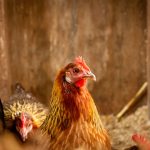Chickens, like all animals, have specific needs for surviving cold weather. Understanding these requirements is essential for maintaining the health and well-being of a flock during winter. While chickens are generally hardy birds, they are vulnerable to cold temperatures without appropriate shelter and care.
In cold weather, chickens need warmth and dryness to prevent illness and injury. They also require access to fresh water and a balanced diet to maintain health and egg production. Protection from drafts and wind is crucial, as is adequate ventilation to prevent moisture and ammonia buildup in their living space.
Chickens are more susceptible to cold weather than commonly believed. Despite their feathers, they can suffer from frostbite and hypothermia without proper shelter and care. Dehydration is also a risk in cold weather, as water can freeze if not maintained at a suitable temperature.
Chickens need to consume more food in cold weather to maintain body temperature, making access to a balanced diet important. By understanding these specific needs, caretakers can take necessary steps to provide chickens with appropriate care and shelter, ensuring their health and comfort during winter months.
Table of Contents
- 1 Providing appropriate shelter for chickens
- 2 Insulating the chicken coop
- 3 Using heat lamps or heating pads
- 4 Providing extra bedding for warmth
- 5 Ensuring access to fresh water
- 6 Monitoring and adjusting for temperature changes
- 7 FAQs
- 7.1 What are the best ways to keep chickens warm on cold nights?
- 7.2 How can I insulate my chicken coop to keep it warm?
- 7.3 Is it safe to use heat lamps or heated pads for chickens?
- 7.4 What temperature should a chicken coop be kept at during cold nights?
- 7.5 How can I ensure good ventilation in the chicken coop while keeping it warm?
Key Takeaways
- Chickens need extra care in cold weather to stay healthy and comfortable
- Providing a well-insulated and draft-free shelter is crucial for chickens in cold weather
- Insulating the chicken coop with materials like straw or hay can help retain heat
- Heat lamps or heating pads can be used to provide additional warmth in the coop
- Adding extra bedding such as straw or wood shavings can help keep chickens warm
- Ensuring access to fresh, unfrozen water is essential for chickens in cold weather
- Regularly monitoring and adjusting for temperature changes is important for the well-being of chickens
Providing appropriate shelter for chickens
Key Features of a Well-Constructed Chicken Coop
A well-constructed chicken coop is essential for the well-being of your flock in cold weather. The coop should be insulated to retain heat and prevent drafts, while also allowing for adequate ventilation to prevent moisture buildup. It should also be raised off the ground to prevent flooding and provide a dry environment for the chickens. Additionally, the coop should be spacious enough to accommodate the entire flock comfortably, with enough roosting space for each bird.
Design and Location Considerations
The design and location of the chicken coop are crucial factors to consider when providing shelter for your flock. The coop should be situated in a well-drained area that receives plenty of sunlight, as this will help keep the interior dry and warm. It should also be positioned away from strong winds and shaded from direct sunlight to prevent overheating in the summer months.
Construction and Security
The coop should be constructed from durable materials that can withstand harsh weather conditions, such as wood or metal. Additionally, it should have a secure door and windows that can be opened and closed as needed to regulate temperature and airflow. By providing appropriate shelter for your chickens, you can create a safe and comfortable environment for them to thrive in all year round.
Insulating the chicken coop

Insulating the chicken coop is an effective way to keep your flock warm and comfortable in cold weather. Proper insulation will help retain heat and prevent drafts, creating a cozy environment for your chickens to roost and lay eggs. There are several ways to insulate a chicken coop, including adding insulation material to the walls, ceiling, and floor.
Common insulation materials include fiberglass, foam board, and reflective foil insulation, which can be installed during construction or added later as needed. Insulating the coop will help maintain a consistent temperature inside, reducing the risk of frostbite and hypothermia in your flock. By insulating the chicken coop, you can create a warm and inviting space for your chickens to thrive in during the winter months.
In addition to insulating the walls, ceiling, and floor of the chicken coop, it is important to seal any gaps or cracks that could allow drafts to enter. This can be done using caulk or weather-stripping around windows, doors, and vents. It is also important to ensure that the coop has adequate ventilation to prevent moisture buildup, which can lead to respiratory issues in chickens.
Proper insulation and ventilation will help create a comfortable and healthy living environment for your flock throughout the winter. By insulating the chicken coop, you can help your chickens stay warm and dry, reducing their risk of illness and injury in cold weather.
Using heat lamps or heating pads
Using heat lamps or heating pads can provide additional warmth for your chickens in cold weather. These devices can be placed inside the chicken coop to create a cozy environment for your flock to roost and lay eggs. Heat lamps are typically suspended from the ceiling of the coop and emit radiant heat, while heating pads can be placed on the floor or under nesting boxes to provide warmth from below.
It is important to use these devices with caution, as they can pose a fire hazard if not installed properly or monitored closely. Additionally, it is important to provide a safe distance between heat sources and flammable materials such as bedding or feathers. By using heat lamps or heating pads, you can help your chickens stay warm and comfortable during the winter months.
When using heat lamps or heating pads in the chicken coop, it is important to consider the specific needs of your flock. Some chicken breeds are more cold-hardy than others and may not require additional heat, while others may benefit from supplemental warmth in extremely cold temperatures. It is important to monitor the temperature inside the coop regularly and adjust the heat source as needed to maintain a comfortable environment for your chickens.
Additionally, it is important to use high-quality heat lamps and heating pads that are designed for use in poultry housing and have built-in safety features such as automatic shutoff switches. By using heat lamps or heating pads responsibly, you can provide your chickens with the extra warmth they need to stay healthy and happy during the winter.
Providing extra bedding for warmth
Providing extra bedding for your chickens is an effective way to keep them warm and comfortable in cold weather. Bedding materials such as straw, hay, or wood shavings can be added to the floor of the chicken coop to provide insulation and create a soft surface for your flock to roost on. The bedding should be kept clean and dry to prevent mold and bacteria growth, which can lead to respiratory issues in chickens.
Additionally, it is important to regularly replace soiled bedding with fresh material to maintain a healthy living environment for your flock. By providing extra bedding for warmth, you can help your chickens stay cozy and content throughout the winter months. In addition to providing extra bedding on the floor of the chicken coop, it is important to add nesting material to the nesting boxes where your hens lay eggs.
This can include straw, shredded paper, or wood shavings, which will provide insulation and cushioning for the eggs as they are laid. The nesting material should be kept clean and dry to prevent contamination of the eggs and provide a comfortable environment for broody hens. By providing extra bedding for warmth in both the coop and nesting boxes, you can help your chickens stay warm and healthy during the winter.
Ensuring access to fresh water

Preventing Water from Freezing
This can include using heated waterers or adding insulation around water containers to keep them from freezing. It is also important to check water sources regularly throughout the day and break up any ice that may form on the surface. By ensuring access to fresh water, you can help your chickens stay hydrated and healthy throughout the winter months.
Maintaining Clean Water Containers
In addition to preventing water from freezing, it is important to ensure that water containers are kept clean and free of debris that could contaminate the water supply. This can include regularly scrubbing waterers with a mild detergent and rinsing them thoroughly before refilling them with fresh water.
Monitoring Water Consumption
It is also important to monitor water consumption in your flock and adjust their diet as needed to ensure they are getting enough hydration in cold weather. By ensuring access to fresh water and maintaining clean water containers, you can help your chickens stay healthy and happy throughout the winter.
Monitoring and adjusting for temperature changes
Monitoring and adjusting for temperature changes is essential for ensuring the comfort and well-being of your chickens in cold weather. It is important to regularly check the temperature inside the chicken coop using a thermometer and make adjustments as needed to maintain a comfortable environment for your flock. This can include adding or removing insulation, adjusting heat lamps or heating pads, or opening windows or vents to regulate airflow.
It is also important to monitor your chickens for signs of discomfort or illness, such as shivering or lethargy, which may indicate that they are too cold. By monitoring and adjusting for temperature changes, you can help your chickens stay warm and healthy throughout the winter months. In addition to monitoring temperature changes inside the chicken coop, it is important to pay attention to external factors that may affect your flock’s comfort level.
This can include changes in weather patterns, such as sudden drops in temperature or heavy snowfall, which may require additional measures to keep your chickens warm and dry. It is also important to consider the specific needs of different chicken breeds, as some may be more sensitive to cold temperatures than others. By monitoring temperature changes both inside and outside the chicken coop, you can take proactive measures to ensure that your flock stays healthy and comfortable throughout the winter months.
In conclusion, understanding the needs of chickens in cold weather is essential for providing them with appropriate shelter and care during the winter months. By insulating the chicken coop, using heat lamps or heating pads, providing extra bedding for warmth, ensuring access to fresh water, and monitoring temperature changes, you can help your flock stay healthy and comfortable throughout the winter months. Taking these steps will not only ensure the well-being of your chickens but also contribute to their overall productivity and happiness as part of your backyard flock.
If you’re looking for tips on how to keep your chickens warm on cold nights, you may also be interested in learning about different types of chicken coops. Check out this article on farmhouse chicken coops for some inspiration on creating a cozy and insulated space for your feathered friends.
FAQs
What are the best ways to keep chickens warm on cold nights?
Some of the best ways to keep chickens warm on cold nights include providing a well-insulated coop, using heat lamps or heated pads, and ensuring good ventilation while avoiding drafts.
How can I insulate my chicken coop to keep it warm?
You can insulate your chicken coop by using materials such as straw, hay, or wood shavings on the floor, adding insulation to the walls and ceiling, and sealing any drafts or gaps.
Is it safe to use heat lamps or heated pads for chickens?
It is safe to use heat lamps or heated pads for chickens as long as they are installed properly and kept away from flammable materials. It’s important to monitor the temperature to prevent overheating.
What temperature should a chicken coop be kept at during cold nights?
A chicken coop should be kept at a temperature of around 45-50 degrees Fahrenheit during cold nights to ensure the chickens stay warm without overheating.
How can I ensure good ventilation in the chicken coop while keeping it warm?
You can ensure good ventilation in the chicken coop by installing vents near the ceiling, using windows with adjustable openings, and avoiding drafts by sealing any gaps or cracks. This helps to maintain air quality while keeping the coop warm.
Meet Walter, the feathered-friend fanatic of Florida! Nestled in the sunshine state, Walter struts through life with his feathered companions, clucking his way to happiness. With a coop that’s fancier than a five-star hotel, he’s the Don Juan of the chicken world. When he’s not teaching his hens to do the cha-cha, you’ll find him in a heated debate with his prized rooster, Sir Clucks-a-Lot. Walter’s poultry passion is no yolk; he’s the sunny-side-up guy you never knew you needed in your flock of friends!







